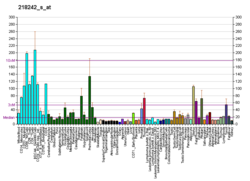Histone-lysine N-methyltransferase KMT5B is an enzyme that in humans is encoded by the KMT5B gene. [5] [6] [7] The enzyme along with NSD2 is responsible for dimethylation of lysine 20 on histone H4 in mouse and humans. [8] [9]
This gene encodes a protein that contains a SET domain. SET domains appear to be protein-protein interaction domains that mediate interactions with a family of proteins that display similarity with dual-specificity phosphatases (dsPTPases). Two alternatively spliced transcript variants have been found for this gene. [7]




